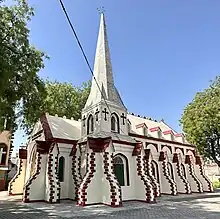William Lowe | |
|---|---|
| Born | William Henry Lowe 30 August 1831 Calcutta, India |
| Died | 30 July 1862 (aged 30) Bulandshahr, India |
| Occupation | District magistrate and collector for Indian Civil Service |
| Known for |
|
William Henry Lowe (30 August 1831 – 30 July 1862), was a British district magistrate and collector of the district of Bulandshahr, during British rule of India.
He led the funding of the construction of the All Saints Church in Bulandshahr. The Lowe memorial building by the district magistrate's court in Bulandshahr was named for him.
Early life and family
William Lowe was born on 30 August 1831 in Calcutta, to John Lowe.[1]
He married a daughter of Sir William Muir.[2] They had a son, William Henry Muir Lowe.[3] Elizabeth Huntley was his only daughter.[4]
Career
Lowe succeeded George Hamilton Freeling as district magistrate and collector for Bulandshahr.[5] In that role he led the funding of the construction of a church on the far west side of Bulandshahr.[2] It was completed in 1864 and later described by the subsequent collector F. S. Growse as a "pretty little building" with the caretakers accommodation as a "practical joke".[2]
Wolf child
The feral child Dina Sanichar, may have been the inspiration for the character Mowgli in The Jungle Book by Rudyard Kipling.[6] The traditional story has been that the boy was brought to the attention of Bulandshahr's district magistrate after hunters discovered the child in a cave in the district of Bulandshahr.[7][8][9] This magistrate has been cited as being Lowe.[7][8][10] However, Lowe had died five years earlier.[2] A letter from W. F. Prideaux to the editor of the North British Advertiser and Ladies Journal (1885) questioned the authenticity of 'wolf boys' in general, and of particularly the one at the "orphanage at Secundra, near Agra".[11] Prideaux requested the name of the magistrate and further details of the wolf boy.[11] In response, the orphanage replied that the boy came to them in 1867 after being found by William Lowe, then collector of Bulandshahr".[11][12] Prideaux noted that no official report on the story existed, and the year and Officer's name was given from a recollection sufficiently long after to question its accuracy.[11]
Death and legacy
Lowe died on 30 July 1862, a day before a planned move to England.[2][13] He is buried in the chancel of Bulandshahr's All Saints Church, which had been commissioned by his widow.[2] The Lowe memorial building by the district magistrate's court, acting as a shelter for those attending the courts, was named for him.[2][14] The inscription read;[14]
This building has been erected by the Europeans and native-official and non-official residents of the station and district as a token of their respect and esteem, and as a memorial of the late William Henry Lowe, Esquire, who died while collector of this district on the 30th of July 1862, AD.
 All Saints Church, Bulandshahr
All Saints Church, Bulandshahr Memorial plaque inside All saints church
Memorial plaque inside All saints church_grave.jpg.webp) Lowe's grave in the chancel of the church
Lowe's grave in the chancel of the church
See also
References
- ↑ Aroles, Serge (2008). L'énigme des enfants-loups: une certitude biologique mais un déni des archives, 1304-1954 (in French). Editions Publibook. ISBN 978-2-7483-8502-1.
- 1 2 3 4 5 6 7 Growse, F. S. (1884). Bulandshahr: Or, Sketches of an Indian District: Social, Historical and Architectural. Benares: Medical Hall Press. p. 78.
- ↑ Westminster, London, England, Church of England Marriages and Banns, 1754-1935
- ↑ "Domestic occurrences". Bangalore Spectator. 16 August 1886. p. 3.
- ↑ Bulandshahr A Gazetteer Vol-v (1922). 1922. p. 118.
- ↑ Sorabji, Caroline (1904). The Wide World Magazine: An Illustrated Monthly of True Narrative, Travel, Customs, and Sport. George Newnes. p. 38.
- 1 2 Ferros, George C. (1902). Sanichar the wolf boy of India . New Year City: [n.p.] pp. 22–28.
- 1 2 Notes and Queries. Oxford University Press. 1886. p. 178.
- ↑ Ha, James C.; Campion, Tracy L. (2018). Dog Behavior: Modern Science and Our Canine Companions. Academic Press. ISBN 978-0-12-816746-5.
- ↑ "Wolf boys". North British Advertiser & Ladies' Journal. 5 September 1885. p. 3.
- 1 2 3 4 "Letters to the editor". Newspaper: North British Advertiser & Ladies' Journal County. Midlothian, Scotland. 5 September 1885. p. 3.
- ↑ Zingg, Robert M. (1940). "Feral Man and Extreme Cases of Isolation". The American Journal of Psychology. 53 (4): 487–517. doi:10.2307/1417630. ISSN 0002-9556.
- ↑ "Died". Southern Reporter and Cork Commercial Courier. 19 September 1862.
- 1 2 Atkinson, Edwin Thomas (1876). Statistical, Descriptive and Historical Account of the North-Western Provinces of India: 3.:Meerut division part 2. North-Western Provinces Government.